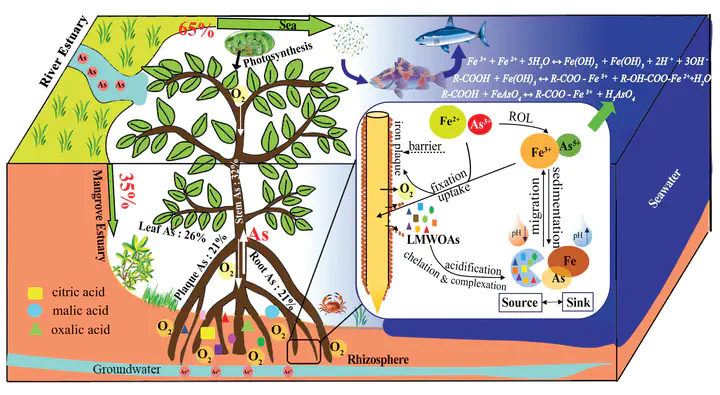2. Low-level arsenite boosts rhizospheric exudation of low-molecular-weight organic acids from mangrove seedlings (Avicennia marina): Arsenic phytoextraction, removal, and detoxification
 Image credit: MEIKANG
Image credit: MEIKANG
Abstract
Arsenic (As) contamination in mangrove wetlands has become a major concern. However, the impact of As on mangroves and the rhizospheric mechanism remains unclarified. In this study, various properties and responses of mangrove seedlings were investigated after exposure to arsenite (As3+). The results indicate that low-level As promoted the secretion of Low-molecular-weight organic acids (LMWOA, 4.5–6.59 mg/kg root in dry weight) and Fe plaque formation in their rhizospheres. Citric, oxalic, and malic acid were the three main components (84.3%–86.8%). Low-level As (5 and 10 μmol/L) also inhibited the rate of radial oxygen loss (ROL) but increased the accumulation of plant As (stem > leaf > root) and plaque As (0.23–1.13 mg/kg root in dry weight). We selected model LMWOAs to further examine As migration and speciation over time in As-enriched sediments (0, 20 and 40 mg/kg). The results reveal that LMWOAs promoted sediment As mobilisation and followed the order of citric acid > malic acid > oxalic acid. The hydrolysis and precipitation of Fe3+ and the complexation with organic ligand led to aqueous As and Fe sedimentation and, conversely, increased solution pH and re-translocated free As. The tolerance mechanisms include lowering ROL, translocating As and releasing LMWOAs to reduce its toxicity, and facilitating the fixation in sediment of oxidised As. The present study highlights the fact that mangroves are potentially favourable for As phytoextraction, removal and detoxification.